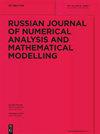非流体静力大气动力学方程数值解的隐式半拉格朗日方法的稳定性分析
IF 0.6
4区 数学
Q4 MATHEMATICS, APPLIED
Russian Journal of Numerical Analysis and Mathematical Modelling
Pub Date : 2021-08-01
DOI:10.1515/rnam-2021-0020
引用次数: 0
摘要
本文分析了非静力大气动力学方程时间积分的隐式半拉格朗日格式的稳定性。所考虑的一类方案不稳定的主要原因是分层热力学变量的半拉格朗日平流与用于解决隐式时间上游轨迹计算问题的不动点迭代方法相耦合。我们识别了两种类型的不稳定模式,并根据方案参数获得了稳定条件。声音模式的稳定需要使用压力参考剖面和时间偏离中心。重力波只对偶数次的不动点方法迭代是稳定的。在不使用潜在温度的参考剖面的情况下,最大时间步长由反浮力频率确定。一般来说,将偏心时间和参考剖面应用于压力变量对于稳定性是必要的。使用潜在温度的参考轮廓和偶数次迭代允许显著增加最大时间步长值。本文章由计算机程序翻译,如有差异,请以英文原文为准。
Stability analysis of implicit semi-Lagrangian methods for numerical solution of non-hydrostatic atmospheric dynamics equations
Abstract The stability of implicit semi-Lagrangian schemes for time-integration of the non-hydrostatic atmosphere dynamics equations is analyzed in the present paper. The main reason for the instability of the considered class of schemes is the semi-Lagrangian advection of stratified thermodynamic variables coupled to the fixed point iteration method used to solve the implicit in time upstream trajectory computation problem. We identify two types of unstable modes and obtain stability conditions in terms of the scheme parameters. Stabilization of sound modes requires the use of a pressure reference profile and time off-centering. Gravity waves are stable only for an even number of fixed point method iterations. The maximum time step is determined by inverse buoyancy frequency in the case when the reference profile of the potential temperature is not used. Generally, applying time off-centering and reference profile to pressure variable is necessary for stability. Using reference profile for potential temperature and an even number of the iterations allows one to significantly increase the maximum time-step value.
求助全文
通过发布文献求助,成功后即可免费获取论文全文。
去求助
来源期刊
CiteScore
1.40
自引率
16.70%
发文量
31
审稿时长
>12 weeks
期刊介绍:
The Russian Journal of Numerical Analysis and Mathematical Modelling, published bimonthly, provides English translations of selected new original Russian papers on the theoretical aspects of numerical analysis and the application of mathematical methods to simulation and modelling. The editorial board, consisting of the most prominent Russian scientists in numerical analysis and mathematical modelling, selects papers on the basis of their high scientific standard, innovative approach and topical interest.
Topics:
-numerical analysis-
numerical linear algebra-
finite element methods for PDEs-
iterative methods-
Monte-Carlo methods-
mathematical modelling and numerical simulation in geophysical hydrodynamics, immunology and medicine, fluid mechanics and electrodynamics, geosciences.

 求助内容:
求助内容: 应助结果提醒方式:
应助结果提醒方式:


